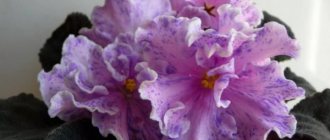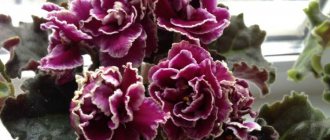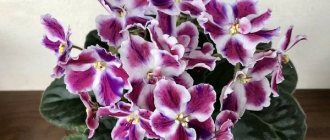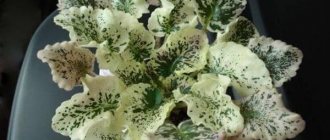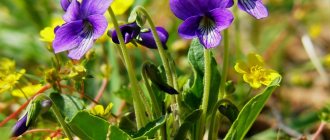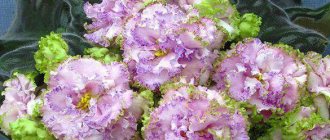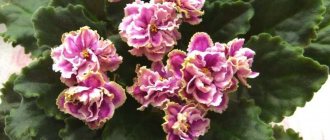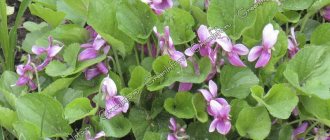Violets are very popular and sought-after indoor plants. With their decorativeness and variety of species and varieties, they captivate the hearts of flower growers.
Breeders managed to develop many forms and colors of this unique crop.
In this article I would like to talk about unusual varieties of green violets (Saintpaulias) and some secrets in caring for them.
After all, an important element of successfully growing a plant you like is studying its characteristics, and in this direction the experience of other gardeners provides significant assistance.
Description
First, let's give a description of the Green Rose violet.
Its leaves are large and slightly wavy at the edges. The predominant color is beautiful, rich dark green. Growth proceeds from the center to the edges, resulting in the formation of a strong rosette.
But, of course, the main feature of the variety is its gorgeous flowers. They consist of numerous petals with wavy edges, arranged in the same way as in rose flowers - hence the name. At the edges the petals are pale yellow or even light green. There are also exquisite inclusions – strokes of lilac color. During one flowering, 6-7 flowers are usually formed. Moreover, with a new flowering, the shade and structure of the flowers can differ significantly - this makes the growing process especially interesting. Colors can also be affected by ambient temperature. If the temperature drops below +20 degrees Celsius, then light colors predominate - yellow and light green. But if the room is hot - above +26 degrees - then a large number of purple and even crimson inclusions appear on the petals. Of course, when choosing a sprout, any florist expects that it will retain the characteristics of the parent plant. However, this is not always observed in violets. Quite often, a young plant has flowers of a different color, very different from the flowers of its parents. Such specimens are usually called “sport”. Violet Green Rose is no exception. Therefore, you should be prepared for this.
Green violet: main characteristics and description of green violet
green violet photo
Such original plants with white-green flowers are called Saintpaulia, which is included in the order of beautifully blooming flowers. The flower got its name simply because it is easy for the average gardener to remember. The name stuck after a long period of time. Therefore, in the article we call the flower a violet, which is the most common word to hear.
If we talk about the nature of the habitat of this species, then wild Saintpaulia will give preference to mountainous areas, for example, East Africa. Flowers are perennial, low growing. Evergreen direction. The stems are relatively small, the basal leaves are very well developed. The leaves have a rounded shape, there are small villi, which can be seen upon careful examination. The tip of the leaf becomes slightly pointed. The color is predominantly green; individuals with spotted foliage are less common.
Flowers formed on violet bushes are endowed with a variety of colors and shapes. The inflorescences are collected in a small brush. The flower is relatively small in size, up to five petals in an inflorescence. At the place of flowering, seeds are formed, collected in a small box.
Suitable soil and pot
Before you start breeding violets, you need to take care of suitable growing conditions. There are several subtleties here that are very important to know about.
First of all, the pot. It would seem that everything is simple here - any container with drainage holes in the lower part will do, so that excess moisture can be freely removed without leading to rotting of the root system. However, the size of the plant should be taken into account here. It is not worth planting a tiny violet in a large pot. Otherwise, the plant will devote all its efforts to developing the root system. This will take many months and all this time the violet will not bloom - hardly anyone will be happy with this situation. Therefore, it is advisable to plant a small leaf with roots in a small pot. Then the root system will quickly occupy the entire available volume and the plant will finally begin to bloom. Over time, the grown plant will need to be replanted - we’ll talk about this a little later.
The choice of soil also needs to be taken very seriously. It is advisable to use fertile soil - black soil or any other soil mixed with compost - an excellent fertilizer. If the soil is too dense, then it would be a good idea to slightly dilute it with sand to facilitate the passage of moisture and oxygen to the roots.
Of course, it is advisable to pour a little crushed stone or pebbles at the bottom of the pot, and only then pour soil on top of them - then the plant will develop most quickly.
Contents in room culture
Standard care is suitable for violet “Sweetie”
- On northern windows it needs lighting, on southern windows it needs shading;
- Watering after drying the top part of the soil, in medium doses;
- Feeding - in case of lack of nutrition;
- Lighting - long-term, diffused spectrum of natural light;
- Temperature - within +20 + 24°C;
- Humidity is increased in any way, but without spraying the violet;
- Substrate – rich in nutrients, with drainage, good aeration and water permeability;
- Transshipment is preferable for transplantation.
Correct conditions
In order for the violet of the Green Rose variety to actively grow and develop, it is necessary to provide it with certain conditions. First of all, these are humidity, temperature and lighting. Let's look at each of the parameters in more detail.
Like most violets, this variety prefers high air humidity - 50% or more. However, at home, this indicator is quite difficult to maintain - especially in winter, when radiators and heating devices dry out the air. Therefore, it would be a good idea to use a special humidifier or simply spray the plants with a spray bottle once or twice a day.
In general, violets are not too demanding on temperature conditions, successfully developing in a fairly wide range. But still, they grow best at temperatures from +18 to +30 degrees Celsius. As mentioned above, the appearance of flowers depends on this indicator.
Any plant needs a sufficient amount of light so that the process of photosynthesis actively occurs in the leaves. In summer there are usually no problems - there is enough lighting. True, you need to make sure that the violet does not get burned from direct sunlight - it is better to place the pot not on the south side. Otherwise, overheating will cause the leaves and flowers to wither and then dry out. But in winter there is clearly not enough light. Therefore, in order for the plant to develop successfully, it is necessary to provide them with a sufficient amount of artificial lighting. Fortunately, coping with the task is not at all difficult - just install a fluorescent lamp on the window.
The most common varieties of violets are green.
green violet photo
Green violet is presented to users in a relatively large variety of species available for cultivation. Below we will look at the most popular varieties, the characteristics of growing each individually and varietal characteristics.
1) “EK-Malachite Orchid” is a representative of a country orchid variety, the difference is the presence of large, slightly double inflorescences, painted in a pronounced cherry color. The border of the petals of the flower is green. The peculiarity in the color of the flower is that when placed in a room at a lower temperature, the green color of the border begins to spread over the entire petal. And then the color of the inflorescences turns into green tones, and the cherry tint can be seen in small specks in the middle of the flower. This feature distinguishes the violet variety; changing shades, depending on climatic conditions, makes it more beautiful, even adding a little sophistication.
2) “LE-Green Rose” are half-double and very beautiful flowers, figuratively they can be compared with the well-known pansy. The color scheme is pink, a more delicate green fringe borders the petals of the inflorescences. The leaves of this plant variety have a slightly waxy coating, formed by a wave. There is a slight drawback to the variety; for those gardeners who prefer to admire flowering over a long period, the flowers fade very quickly.
3) “RS-Emerald City” - the inflorescences of this variety are painted white with a green tint, a transitional palette of shades, to soft blue at the very edge of each petal. Additionally, the petals are framed with a fringe of greenish tint. Formation of sheet plates according to the standard, almost rounded shape.
4) "N-Green tea" - a representative of the variety - an unusually beautiful violet. It is formed in the form of a compact bouquet, which consists of small, beautiful flowers covered with light terry. The very delicate white, slightly green color of the inflorescences attracts the admiring glances of most beauty connoisseurs. There are cases when a pinkish tint can be seen along the edge of the petals. The variety differs in the duration of flowering. A very attractive feature of the formation of leaf plates, attractive hearts, are painted in dark greenish tones.
A beautiful flower, endowed with slightly double and fairly large flowers, which are painted in a purple hue. Along the edge of each petal there is a frame with a thin border of a green tone. At the edges of the petals, when fully developed, they begin to curl a little. Figuratively, this picture is similar to nodules. A pronounced border is most visible in areas with a cool climate. Or in a room with low temperatures. Violet blooms for quite a long time. This process depends on the fact that the petals tend to open not simultaneously, but one by one, hence the flowering process is delayed. Shaping of sheet plates according to standards. The advantage of this variety is its minimal care requirements.
5) “RS-Green Lagoon” - this Saintpaulia has big differences from its relatives, the color scheme of the petals is bright, even a little unusual. The petals located on the outside are painted with a delicate green tint, the main part of the flower is snow-white petals, but almost every petal has subtle blue streaks, which adds to the charm of the flower. The formation of the bud is somewhat reminiscent of the velcros of ordinary cabbage. Based on the observations of experienced flower growers, we can emphasize another originality of flowers; with age, their color darkens a little. Flowering continues for a long period. With proper care, this violet can delight the eye with flowering all year long, with short breaks.
6) Green dragon - the difference between this variety is the presence of flowers of different types. Some are fully terry, the other half are partially terry. The color of the inflorescences is predominantly white. There is a light border along the edge of each petal. But there is also a disadvantage to this variety of Saintpaulia - it has a short flowering period. The plant also needs constant and abundant sunlight, of course without direct sunlight. In the absence or part of this requirement, violets take on a faded color.
7) “RS-Green Corals” - the original structure of the inflorescences resembles an asterisk, the petals are painted white and blue. The edges of the petals are framed by a thin border of green tint and a slight velvety feel. It is characterized by very rare flowering, but the duration of this process is almost 30 days for each individual inflorescence. The corrugated shape of the leaf plates attracts with a brilliant green tone. The bush of such Saintpaulia is large in size, this also applies to the formed buds.
8) Ness pixie grin-violet of this variety was bred by selective breeding by foreign scientists. What distinguishes it from all other representatives of this culture is the increased doubleness of the inflorescences; the flowers themselves are not very large and outwardly resemble the well-known pansy flower. The color is very unusual, even the original rosette of the inflorescence is painted a soft green cream color, and the rest has a coral tint. Sheet plates have increased fragility. When replanting a plant, this feature must be taken into account.
9) “KO-Young-Green” - a domestic breeder developed this violet variety at the end of the 20th century. Attractive, soft white color of the flowers and doubleness covering a significant part of the petals. A pronounced green border along the edge of each petal. Sometimes, you can observe small fragments (blotches) on flowers, the color of the fragments is blue. But such a miracle appears selectively, not on every inflorescence or individual petal. The leaves are medium sized, round in shape.
10) “RS-Green Moss” - this violet was bred by the famous domestic breeder Repkin. Semi-double, delicate green petals attract attention. On individual petals you can see small purple stains. Along the edge of each petal there is a terry border, corrugated in shape. The large leaves have a wavy shape and are painted in a pronounced green color. Violet of this variety loves a lot of light. If you follow all the rules for planting and subsequent care, then the plant will delight you with abundant and long-lasting flowering.
11) “EK-Green Cockatoo” - the impressions from the appearance of the violet bush and flowers can be described as follows: green parrots gathered in a flock and settled on shiny green leaves. Why such associations? The flowers are double, the petals are slightly oblong in shape, the number and size of each flower resemble pansy bushes. The color of the petals is bright, light green. The edge of each petal is a pronounced green tone.
12) “EK-Green chrysanthemums” - the inflorescences of this violet resemble a medium-sized pompom in their shape. They are terry and have a bright white color. The edge of each petal is framed by a green border. Some of the inflorescences have pink inclusions in the middle rosette.
13) Wrangler's green pastures variety is endowed with significantly larger flowers, covered with terry and painted white. Sometimes some of the petals turn pink. The corrugated border around the edge of the inflorescences is green. The green leaves are also corrugated and sometimes have a silvery tint.
14) Green horizon - a variety selected abroad. The difference lies in the color of each petal: the main part is terry snow-white, along the edge of the petals there is a wide border of a pronounced green tone. The color range of flowers is predominantly white at the beginning of flowering, but throughout the color process the color gradually changes, the petals are almost completely painted in a green tone. The size of the inflorescences increases with the size of the violet bush itself. The flowering process is distinguished by its long period. The large leaves are colored green.
15) “EK-Green-Eyed Blonde” - attracts with its bright salad shade of large inflorescences, which are framed by a small velvety border, and the edges of each petal are slightly jagged, which gives unique originality to the flower as a whole. The wavy shape of the leaf plates, also endowed with a small fringe along the edge, is painted green.
16) Louisiana green - this variety can be characterized by the following parameters: the inflorescences are white, there is a slight lilac tint, there is a thin border along the edge, of a velvety green hue. Wavy leaves. A full examination of this variety of violet creates an impressive picture that will not leave anyone indifferent and will certainly attract you to plant it on your windowsill.
There is a lot more that can be listed about the variety of Saintpaulias, but for now we will focus on those already discussed. It is these varieties that are most attractive and popular among flower growers.
Germination and planting
Now let's talk about the propagation of Green Rose violets. Flowers are quite easy to germinate. If you see a beautiful plant from your friends, you can simply ask them to separate a single leaf from it. Of course, it is advisable to choose an even, beautiful and large leaf, and not from the edge, but directly from the center - they receive the most nutrients, which is why they are the most viable. After that, half the work is already done!
All that remains is to place the leaf in a small container of water. Make sure that the lower end (cut) is always in water and never dries out - this will lead to the death of the plant. But at the same time, only the cutting itself should come into contact with water, and not the leaf - otherwise excess moisture will have a bad effect on it, and even rot may appear.
After a few days, small roots will appear at the bottom of the leaf. So it’s time to plant the plant in the ground. What soil and pot to choose is described above. All that remains is to moisten the soil well, dig a small hole in it, place a leaf there so that all the roots are in the hole, and carefully cover it with soil on top, lightly compacting it for density. That's all! Now the plant will probably actively grow and develop.
Violet Natalie: reproduction
Violet Natalie: video about the variety
Natalie's violet can be propagated in several ways. This is best done through cuttings. In order to propagate the plant, you will need to select a healthy and strong leaf from the second or third row, separate it from the plant at an angle of 45 degrees. However, it is better not to use too young or old leaves for this. It is recommended to treat the cut area with crushed activated carbon. After this, the cutting is placed in the root to stimulate the formation of the root system. Then the leaf can be placed in water or rooted in loose and nutritious soil. The plant does not need high humidity, as this often causes the foliage to rot, so you can try rooting the cuttings in sphagnum. When the first roots appear on the leaf, you can plant Natalie’s violet in small pots. The soil in the container must be nutritious and fertile, and most importantly well structured and loose. Do not forget about high-quality watering; in order for the plant to develop better, you can temporarily cover the pot with film. The rosette of Natalie's violet will form in a couple of weeks, and within a month the violet can be planted in its permanent habitat. As you can see, propagating Natalie violets is not that difficult, and growing violets is actually quite easy.
A little about watering
Violets should be watered as the soil dries. Accordingly, this will have to be done more often in the summer, and less often in the winter. In addition, the soil dries out faster in small pots than in large ones.
Watering should be done only with settled water - not cold from the tap. It is advisable to pour water into a suitable container - a glass, jar or any other with a wide neck (to facilitate the process of chlorine evaporation) and leave for a day. During this time, it will warm up to room temperature and get rid of dangerous chlorine. Too hot or cold water may well lead to diseases and damage to the roots.
When watering, try to pour water directly onto the ground. If it gets on the leaves on a hot sunny day, burns are possible - white spots will appear on their surface.
Types of wild violets
The natural distribution range of wild violets is limited to certain mountainous areas in Tanzania and Kenya. There it can be found along the banks of rivers flowing down steep mountain slopes, near waterfalls that irrigate the surrounding area with water dust, at the bottom of ravines in the partial shade of tall trees. In direct sunlight, this violet quickly dies. About 20 species of Saintpaulia grow under natural conditions. Let us introduce you to some of them.
Velvet
Saintpaulia velutina has jagged, rounded dark green leaves, 4-5 cm in size. The reverse side of the leaf has a reddish tint. The lush inflorescence consists of small blue-violet flowers with a dark center.
Grote
Grote (Saintpaulia grotei) is an ampel-type plant that has rounded pubescent leaves of bright green or purple color up to 6 cm long and about 5 cm wide. Small blue-purple flowers up to 2.5 cm in diameter have a dark eye and border.
Violet-flowered
Violet-flowered or violet-flowered (Saintpaulia ionantha) . The plant has a large rosette, up to 60 cm in diameter, short succulent stems with heart-shaped, dark green leaves up to 8 cm in length. The flowers are violet-blue in color.
Transplantation
It was already mentioned above that violets need to be replanted regularly. Up to one year it can easily grow in a small pot. But then you should transplant it into a larger pot and repeat the procedure every two years.
Old plants especially cause a lot of trouble. It is not enough to simply replant them - you need to carefully remove the outer leaves directly from the rhizome, leaving only the middle. This rejuvenation of plants leads to active growth.
With young violets everything is much simpler. You need to prepare a pot into which you plan to transplant the plant, pour soil into it and make a large depression in it. The soil in the pot with the violet needs to be slightly moistened, and then carefully turned over, trying to shake it out along with the plant - here it is very important not to damage the root system, otherwise the violet will hurt and may even die. All that remains is to place the soil in the prepared hole and water it well.
Violet AB-Ring with ruby
A spectacular variety obtained by breeder Alexey Vsevolodovich Tarasov . The violet was presented to amateur flower growers in 2015.
Photo and description of the variety
Violet AB-Ring with ruby (photo located just above) belongs to the small standard type , preferring to form a rosette along the lower standard border. The contour of the rosette is always smooth, symmetrical , the leaves are arranged compactly.
The medium-sized leaf blades are distinguished by wavy-toothed dimensions, a glossy surface and a light venation pattern against the overall dark background of the plate with a slight swampy tint.
Flowering occurs with the formation of multiple elongated but strong peduncles with three buds each. As they grow, the flowers increase in diameter.
a crimson ruby color as the flower matures . At the same time, the underside of the petals does not change their light color.
Each corolla is bordered by a thick burgundy-golden fringe edge, the density and corrugation of which intensifies over time of flowering.
Saintpaulia petals are characterized by an almost plastic structure, which significantly increases the viability of the flowers.
The variety readily produces stepsons and often goes into sports.
Features of maintenance and care
To develop the juicy ruby color of the flowers, violets should be kept in a warm microclimate - at cool temperatures, the corollas remain light in color.
ATTENTION! A feature of the variety can be called the desire of the plant to wrap the leaves down towards the flowerpot. Therefore, the formation of the rosette should be done using a corset.
When replanting Saintpaulia, it is necessary to form a good drainage cushion in the new pot - this will protect the plant from stagnation of moisture and rotting.
Activated carbon can be used as an antiseptic by mixing its pieces with the substrate.
Reviews
Faina Dmitrievna. “The variety “AB-Ring with Ruby” amazed me with the spectacular structure of its flowers with a thick fringe and a beautiful juicy color of dark pink ruby. I got a leaf and grew it. But no matter how many times it didn’t bloom for me, it always remained a pinkish tint. I started to look into it: it turned out that the violet was cold on the window. I put it on the rack and soon got a lot of shaggy dark rubies.”
Anna. “Thank you to the Violetgrower for the magnificent Saintpaulia “AB-Ring with ruby.” This is my favorite variety at the moment. A neat rosette, patterned leaves and rubies in a gold frame – there are simply no words! Delight!"
Don't forget about fertilizers
For the first six months after planting in fresh soil, there is no need to fertilize the violet - the soil contains all the necessary substances. Then you need to feed the flower every two weeks - this is especially important during the flowering period.
An actively growing plant needs to be fertilized with nitrogen fertilizers - they ensure rapid growth of green mass (stems, leaves). Immediately after transplanting, you can add a little phosphorus, which is needed for the rapid development of the root system. But before flowering, you need to fertilize the violet with potassium fertilizers - then there will be more buds and their size will also increase.
Of course, when fertilizing, carefully study the instructions so as not to harm the plant due to excess microelements.
Violet EK-Royal ruby
The violet EK-Royal ruby, the photo and description of which is presented below, was bred by a breeder from Togliatti, Elena Vasilyevna Korshunova. Violet first appeared at exhibitions in 2002.
Photo and description of the variety
Based on the size of the bush, Saintpaulia is classified according to the standard type. The plant forms a fairly large leaf rosette, which, if there are errors in the level of illumination (in low light), may have an uneven, spreading outline.
After eliminating negative factors, the rosette acquires clear, full outlines.
Leathery, glossy surface leaves of a dark green shade with an emerald spot along the vein at the very base sit on somewhat elongated petioles. A special feature of the variety is the edges of smooth leaf blades turned down and a clear venation pattern.
The variety blooms with very large corollas of semi-double fullness , which gradually develops into double, intensifying from flowering to flowering:
- the petals are distinguished by a slightly wavy edge, sometimes tinted with a dark shade;
- the color of the corolla ranges from a ruby tint with raspberry highlighting to a thick fuchsia shade ;
- violet blooms in a cap , with long-term preservation of the freshness of each corolla.
The variety is often used for sports.
Features of maintenance and care
The variety is very sensitive to lack of lighting , and therefore requires location on southern window sills, subject to obligatory shading in the heat of the summer afternoon.
To maintain the decorativeness of violets at the proper level, it is necessary to pay special attention to the amount of light .
IMPORTANT! At low light levels, Saintpaulia pulls out leaf petioles and peduncles, which become unable to support heavy corollas and fall on the foliage.
Violet can cause a lot of trouble when forming a rosette - it does not immediately give a symmetrical outline. It is better to use a corset, and mandatory lighting conditions can protect against the bush being pulled out.
Reviews
Serafima Ilyinichna. “I really love Elena Vasilyevna’s varieties. But I had to give the violet “EK-Royal Ruby” to my daughter. All the windows in my apartment are north-facing, the violet didn’t like it. She grew long petioles of leaves, which is why she acquired a shaggy appearance. And all the buds were just lying on the rosette.”
Igor Pavlovich. “I have been growing Saintpaulia “EK-Royal Ruby” for a long time. The flower constantly pleases with the lush formation of ruby buds with a crimson tint. I especially like the unexpected accent - the bright central vein on the leaves.”
Possible difficulties during cultivation
Most often, violet lovers encounter aphids and mites. The appearance of aphids can be noticed by the gradually curling leaves. The problem is solved after treating the leaves with a special powder preparation - Mospilan.
Mites most often appear on old, drying leaves. Therefore, if you spend at least a few minutes a couple of times a week removing dry leaves, you will probably not encounter this problem.
Reviews
Raisa, Moscow. “I grow all the children that the cutting produces. As they grow, I select specimens with the most compact sockets. I delete all the others. The phenomenon of spider legs is quite common among violets. It was standing on the windowsill, but now I put it under the lamp and double flowers appeared.”
Karina, Mariupol. “My violet’s rosette has reached 30 cm. It’s the only one among all varieties. I decided to break it off a little to check the size. If it is too light, the leaves immediately begin to lift up. I don’t use a pot larger than seven, otherwise she will grow up to be a real elephant.”
Violets EK-Ruby Moon
Another magical variety developed by E.V. Korshunova . Presented at exhibitions since 2011 .
Photo and description of the variety
The violet rosette develops according to the standard type , growing perfectly even, symmetrical, and of small diameter.
Due to small edge waves, the leaf plates take on the shape of an elongated boat. The color scheme of the leaves varies from rich to dark tones.
Violet flowering occurs in a cap type , but the size of the cap is never too large:
- the buds bloom in large corollas of terry fullness. Volume is added by the wavy edges of the petals;
- The corollas are painted in a dark ruby color with a white ribbon appearing along the contour ;
- As the flower ages, its color does not fade .
Features of maintenance and care
Violet is suitable for inclusion in the collections of novice gardeners, as it grows quickly, is not picky, blooms easily and for a long time.
ADVICE! The decorativeness of the variety depends on temperature indicators - in extreme heat, the white edging of the petals may disappear, and in cool conditions, the color intensity, width of the edging and terryness of the corollas intensify.
If all care regimens are followed, the brightness and size of the flowers invariably increases with each flowering.
With additional lighting, Saintpaulia should be placed away from the light source so that the central part of the socket is not clogged, otherwise thinning will be required.
Reviews
Julia. “I want to share my joy: “Ruby Moon” bloomed for the second time and produced large double flowers of juicy ruby with a white ribbon along the edge! During the first flowering, all this was not there, then several small, weak buds bloomed. But now it’s just great!”
Nikolai Stepanovich. “I’ve been taking my “Ruby Moon” to exhibitions for several years now. Its perfect rosette and ruby flowers attract attention. They constantly admire her and ask for leaves.”
